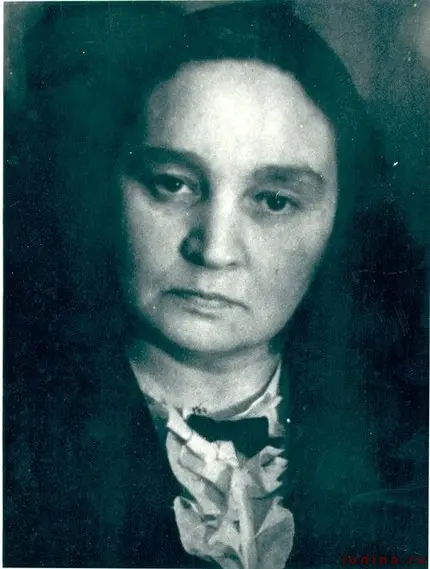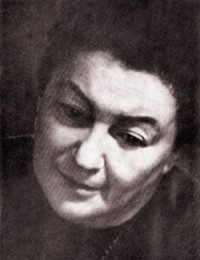
Maria Veniaminovna Yudina |
Maria Yudina

Maria Yudina is one of the most colorful and original figures in our pianistic firmament. To the originality of thought, the unusualness of many interpretations, the non-standard of her repertoire was added. Almost every performance of hers became an interesting, often unique event.
- Piano music in the online store OZON.ru
And every time, whether it was at the dawn of the artist’s career (the 20s) or much later, her art caused fierce controversy among the pianists themselves, and among critics, and among listeners. But back in 1933, G. Kogan convincingly pointed to the integrity of Yudina’s artistic personality: “Both in style and in the scale of her talent, this pianist does not fit into the usual framework of our concert performance so much that it plunges musicians brought up in the traditions romantic epigonation. That is why the statements about the art of M. V. Yudina are so diverse and contradictory, the range of which extends from accusations of “insufficient expressiveness” to accusations of “excessive romanticization”. Both accusations are unfair. In terms of the strength and significance of the expression of pianism, M.V. Yudina knows very few equals on the modern concert stage. It is difficult to name a performer whose art would impose on the soul of the listener such an imperious, strong, chased stamp as the 2nd part of Mozart’s A-dur concerto performed by M. V. Yudina … M. V. Yudina’s “Feeling” does not come from cries and sighs: by means of tremendous spiritual tension, it is drawn out into a strict line, concentrated on large segments, ground into a perfect form. To some, this art may seem “inexpressive”: the inexorable clarity of the game of M. V. Yudina too sharply passes by many of the expected “cozy” mitigations and roundings. These features of the performance of M. V. Yudina make it possible to bring her performance closer to some modern trends in the performing arts. Characteristic here is the “polyplan” of thinking, “extreme” tempos (slow – slower, fast – faster than usual), a bold and fresh “reading” of the text, very far from romantic arbitrariness, but sometimes sharply at odds with epigone traditions. These features sound different when applied to different authors: perhaps more convincing in Bach and Hindemith than in Schumann and Chopin. An insightful characterization that retained its strength for the following decades …
Yudina came to the concert stage after graduating from the Petrograd Conservatory in 1921 in the class of L. V. Nikolaev. In addition, she studied with A. N. Esipova, V. N. Drozdov and F. M. Blumenfeld. Throughout Yudina’s career, she was characterized by artistic “mobility” and a quick orientation in the new piano literature. Here, her attitude to musical art as a living, continuously developing process affected. Unlike the vast majority of recognized concert players, Yudin’s interest in piano novelties did not leave him even in his declining years. She became the first performer in the Soviet Union of works by K. Shimanovsky, I. Stravinsky, S. Prokofiev, P. Hindemith, E. Ksheneck, A. Webern, B. Martin, F. Marten, V. Lutoslavsky, K. Serotsky; Her repertoire included D. Shostakovich’s Second Sonata and B. Bartok’s Sonata for Two Pianos and Percussion. Yudina dedicated his Second Piano Sonata to Yu. Shaporin. Her interest in everything new was downright insatiable. She did not wait for recognition to come to this or that author. She walked towards them herself. Many, many Soviet composers found in Yudina not just understanding, but a lively performance response. In her repertoire list (in addition to those mentioned) we find the names of V. Bogdanov-Berezovsky, M. Gnesin, E. Denisov, I. Dzerzhinsky, O. Evlakhov, N. Karetnikov, L. Knipper, Yu. Kochurov, A. Mosolov, N. Myaskovsky, L. Polovinkin, G. Popov, P. Ryazanov, G. Sviridov, V. Shcherbachev, Mikh. Yudin. As you can see, both the founders of our musical culture and the masters of the post-war generation are represented. And this list of composers will expand even more if we take into account the chamber-ensemble music-making, which Yudina indulged in with no less enthusiasm.
A common definition – “propagandist of modern music” – right, sounds too modest in relation to this pianist. I would like to call her artistic activity propaganda of high moral and aesthetic ideals.
“I have always been struck by the scale of her spiritual world, her enduring spirituality,” writes the poet L. Ozerov. Here she is going to the piano. And it seems to me, and to everyone: not from the artistic one, but from the crowd of people, from her, this crowd, thoughts and thoughts. He goes to the piano to say, convey, express something important, extremely important.
Not for a pleasant pastime, music lovers went to Yudina’s concert. Together with the artist, they had to follow the content of classical works with an unbiased eye, even when it was about well-known samples. So again and again you discover the unknown in the poems of Pushkin, the novels of Dostoevsky or Tolstoy. Characteristic in this sense is the observation of Ya. I. Zak: “I perceived her art as human speech – majestic, stern, never sentimental. Oratory and dramatization, sometimes … not even characteristic of the text of the work, were organically inherent in Yudina’s work. Strict, true taste completely excluded even the shadow of reasoning. On the contrary, she led into the depths of the philosophical comprehension of the work, which gave such tremendous impressive power to her performances of Bach, Mozart, Beethoven, Shostakovich. The italics that stood out clearly in her courageous musical speech were completely natural, in no way intrusive. He only singled out and emphasized the ideological and artistic intent of the work. It was precisely such “italic” that demanded the exertion of intellectual forces from the listener when he perceived Yudin’s interpretations of, say, Bach’s Goldberg Variations, Beethoven’s concertos and sonatas, Schubert’s impromptu, Brahms’s Variations on a Theme by Handel… Her interpretations of Russian music were marked by a deep originality , and above all “Pictures at an Exhibition” by Mussorgsky.
With the art of Yudina, albeit on a limited scale, the records she played now make it possible to get acquainted. “Recordings, perhaps, are somewhat more academic than live sound,” N. Tanaev wrote in Musical Life, “but they also give a fairly complete picture of the creative will of the performer … The skill with which Yudina embodied her plans always aroused surprise. Not the technique itself, the unique Yudinsky sound with the density of its tone (listen at least to its basses – the powerful foundation of the entire sound building), but the pathos of overcoming the outer shell of the sound, which opens the way to the very depth of the image. Yudina’s pianism is always material, every voice, every single sound is full-bodied … Yudina was sometimes reproached for a certain tendentiousness. So, for example, G. Neuhaus believed that in her conscious desire for self-affirmation, the strong individuality of a pianist often remakes the authors “in her own image and likeness.” It seems, however (in any case, in relation to the late work of the pianist) that we never meet Yudina’s artistic arbitrariness in the sense of “I want it that way”; this is not there, but there is “as I understand it” … This is not arbitrariness, but its own attitude to art.





